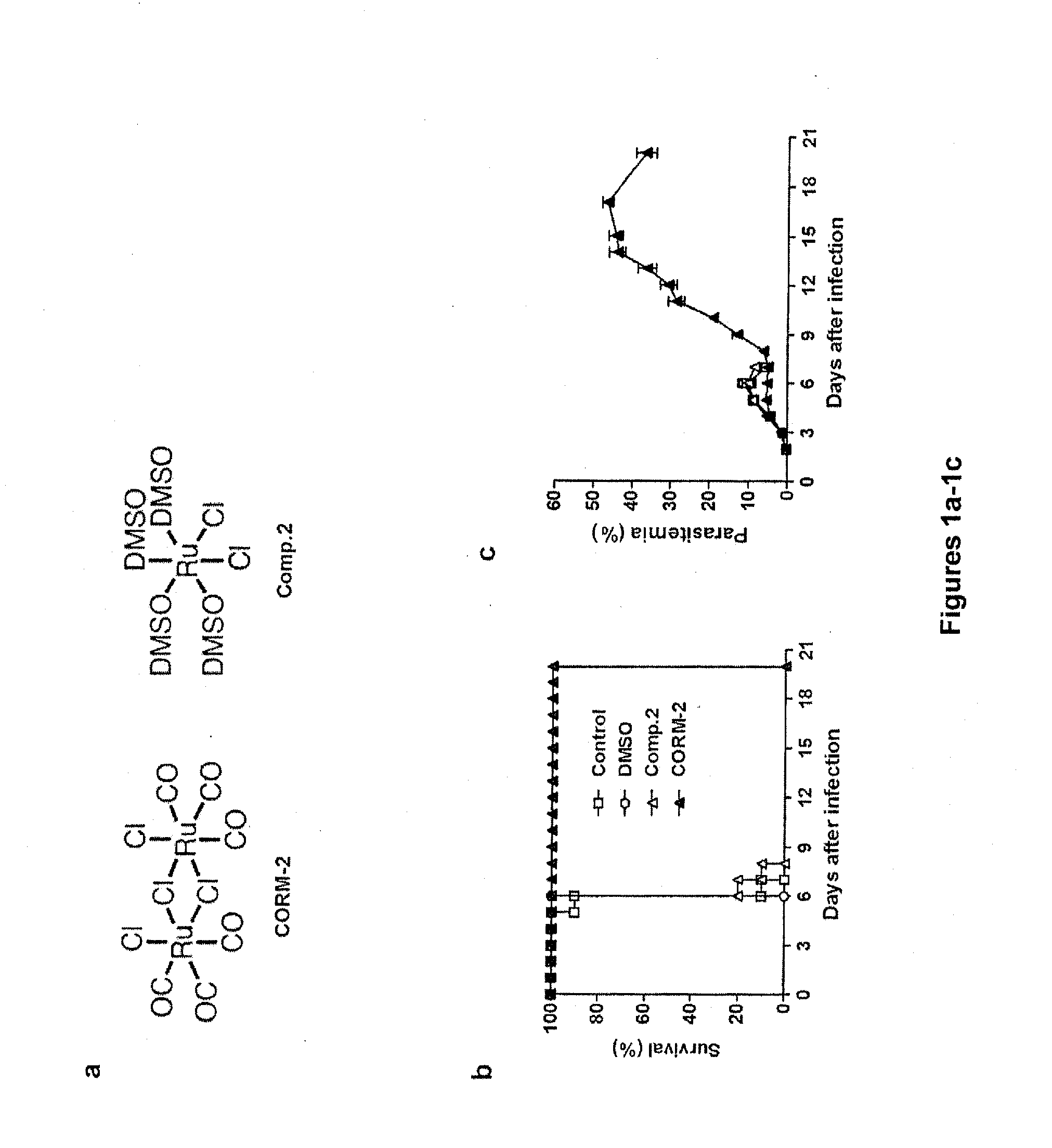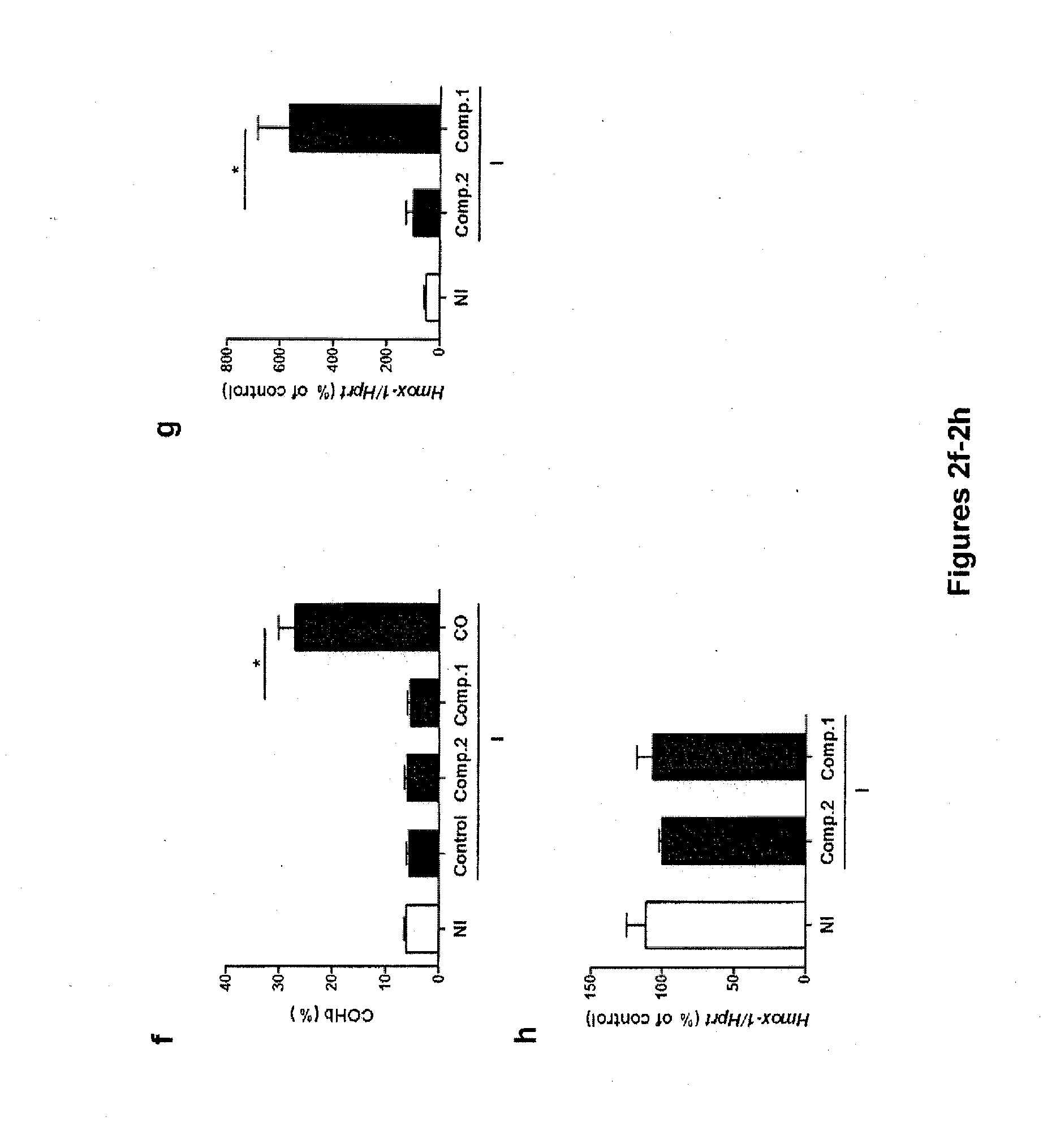Ruthenium carbon monoxide releasing molecules and uses thereof
- Summary
- Abstract
- Description
- Claims
- Application Information
AI Technical Summary
Benefits of technology
Problems solved by technology
Method used
Image
Examples
example 1
CORM-2 Protects Against ECM Development
[0177]It has previously been shown that administration of CO by inhalation protects P. berghei ANKA infected C57BL / 6 mice from developing ECM (see, e.g., Pamplona et al. Nat Med (2007) 13:703-710). The inventors questioned whether CO-RMs could mimic the protection conferred by CO inhalation in P. berghei ANKA infection. To this end, a known ruthenium CORM, Ru(CO)3Cl2, also referred to herein as CORM-2, was tested on different schedules of treatment and doses in P. berghei ANKA infected C57BL / 6 mice (data not shown). As negative control, a CO-depleted analogue of CORM-2, [Ru(DMSO)4Cl2] (also referred to herein as “Compound 2”) where all CO ligands of Ru(II) are replaced by DMSO ligands (FIG. 1a) was used. Treatment twice daily with CORM-2 between days 2 and 3 after infection prevented death or symptoms of ECM in all infected C57BL / 6 mice (P30% infected red blood cells) and were sacrificed 3 weeks after infection (FIG. 1b,c). In contrast, mice in...
example 2
A Novel CO-Releasing Molecule (Compound 1) Protects Mice from ECM without COHb Formation
[0179]A novel water soluble CO-RM, tricarbonyldichloro(methylthiogalactopyranoside) Ru(II) [Ru(CO)3Cl2(Gal-S-Me)](Compound 1), was synthesized through the reaction of CORM-2 with methylthiogalactopyranoside (Gal-S-Me) (FIG. 2a). This Ru tricarbonyl complex features a galactose (Gal) derived ligand coordinated to the Ru centre via a thioether linkage. The presence of the galactose ligand may confer a certain degree of liver specificity.
[0180]Tricarbonyldichloro(methylthiogalactopyranoside) Ru(II) [Ru(CO)3Cl2(Gal-S-Me)], also referred to herein as Compound 1, was prepared by reacting CORM-2 with methylthiogalactopyranoside (Gal-S-Me) as described herein (see FIG. 2a and Materials and Methods section). The bio-distribution of Compound 1 in tissues was assessed by quantifying the levels of Ru and CO in the host by the method of Vreman et al., Anal Biochem (2005) 341:280-9. Liver, kidney, spleen, lung...
example 3
Compound 1 Induces the Expression of HO-1
[0186]It has been shown that HO-1 induction reduced CM incidence in P. berghei ANKA infected C57BL / 6 mice (see, e.g., Pamplona et al., Nat Med (2007) 13:703-710). Compound 1 distributes preferentially to the liver, which is considered a mediator of systemic and local innate immunity and has been implicated in the regulation of genes that contribute to the control of inflammation, such as HO-1 (see, e.g., Nemeth et al., Semin Immunopathol (2009) 31:333-343). No signs of ruthenium are found in the brain. The inventors questioned whether Compound 1 could modulate the expression of HO-1 and thus contribute to the observed protection against ECM. Expression of HO-1 mRNA was significantly up-regulated in the liver of P. berghei ANKA infected Compound 1-treated C57BL / 6 mice, 11.1±2.3 and 5.7±1.2 fold, when compared, respectively, to non-infected and infected Compound 2-treated mice (Pg). Moreover, the expression of HO-1 mRNA in the brain of infected...
PUM
| Property | Measurement | Unit |
|---|---|---|
| Stereoisomer | aaaaa | aaaaa |
Abstract
Description
Claims
Application Information
 Login to View More
Login to View More - R&D
- Intellectual Property
- Life Sciences
- Materials
- Tech Scout
- Unparalleled Data Quality
- Higher Quality Content
- 60% Fewer Hallucinations
Browse by: Latest US Patents, China's latest patents, Technical Efficacy Thesaurus, Application Domain, Technology Topic, Popular Technical Reports.
© 2025 PatSnap. All rights reserved.Legal|Privacy policy|Modern Slavery Act Transparency Statement|Sitemap|About US| Contact US: help@patsnap.com



